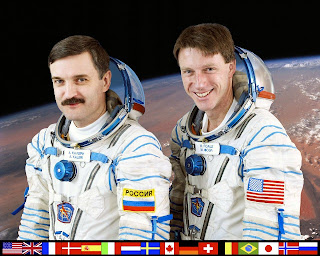Cosmonaut Pavel V. Vinogradov (center), Expedition 13 commander representing Russia's Federal Space Agency, astronaut Jeffrey N. Williams (right), NASA space station science officer and flight engineer, and European Space Agency (ESA) astronaut Thomas Reiter of Germany pause from their training schedule to pose for their official crew portrait. Vinogradov and Williams are scheduled to be launched to the International Space Station in early spring of this year in a Soyuz TMA-8 spacecraft. Reiter, the second flight engineer for Expedition 13, is scheduled to launch on space shuttle mission STS-121 in July and will join Vinogradov and Williams already on the space station. Photo credit: Gagarin Cosmonaut Training Center/NASA
This patch commemorates the thirteenth expeditionary mission to the International Space Station (ISS) which continues the permanent human presence in space. The ISS is depicted in its configuration at the start of the six-month expedition with trailing elements from the country flags representing each of the three crew members. The crew members made the following statement about their patch: "The dynamic trajectory of the space station against the background of the Earth, Mars, and the Moon symbolizes the vision for human space exploration beyond Earth orbit and the critical role that the ISS plays in the fulfilment of that vision."
Variations on the International Space Station Mission patch included a two flag version below.














